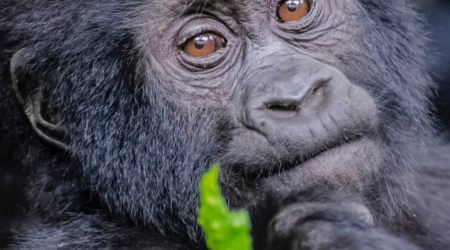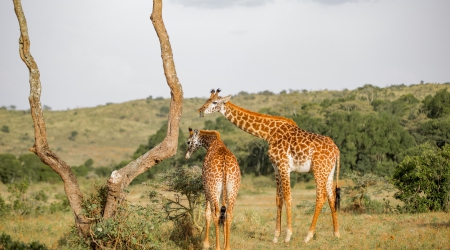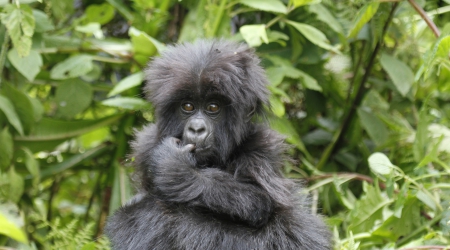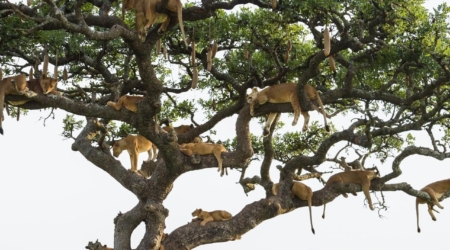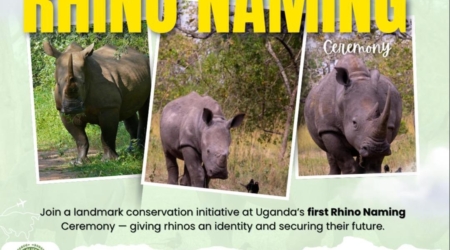The phrase Big Five originated in colonial-era hunting records. It referred to the five most challenging animals to pursue on foot: lion, elephant, leopard, buffalo, and rhinoceros. Today, the term defines one of the core benchmarks for wildlife tourism across sub-Saharan Africa. While several destinations market Big Five safaris, only a few support viable sightings of all five species in the wild.
Uganda is one of them. The country’s national parks and wildlife sanctuaries protect viable populations of four out of the five species in open, unfenced ranges. The fifth, the white rhinoceros, has been reintroduced into controlled sanctuary environments under active monitoring. These efforts reflect more than animal presence; they demonstrate political will, scientific management, and historical recovery efforts.
If you are planning a safari to Uganda and hoping to see the Big Five, this article will offer clear directions. Each species requires a different approach, and each park offers different probabilities. Uganda’s Big Five offering is not theoretical or symbolic. It is grounded in real data and verifiable sightings, backed by conservation structures that date back over a century. In a moment, we’ll examine each species individually, followed by guidance on where and how to see them.
What Are the Big Five Animals?
The phrase Big Five first appeared in British and South African hunting records during the late 1800s. It described five African mammals considered the most dangerous and challenging to track and kill on foot. These animals: lion, leopard, elephant, buffalo, and rhinoceros, were not the largest or rarest, but the most formidable for professional hunters operating with limited equipment in unfamiliar territory.
In today’s context, the term has undergone a significant shift. Wildlife tourism now uses Big Five as a shorthand for key safari targets, not trophies. The modern significance lies in their ecological stature, behavioural intrigue, and visibility across protected ecosystems. For Uganda, inclusion in the Big Five circuit carries weight. It signals not only species presence, but credible infrastructure for viewing, conservation, and habitat protection.
1. The African Lion (Panthera leo)
This species remains the apex predator of Uganda’s savannah zones. Its territorial system, pride dynamics, and daytime visibility make it a central species for safari guests. Lions in Uganda show local adaptations, especially in areas like Ishasha, where tree-climbing behaviour is routine rather than rare. On conservation registers, lions are classified as Vulnerable due to habitat pressure and declining prey densities across East Africa.
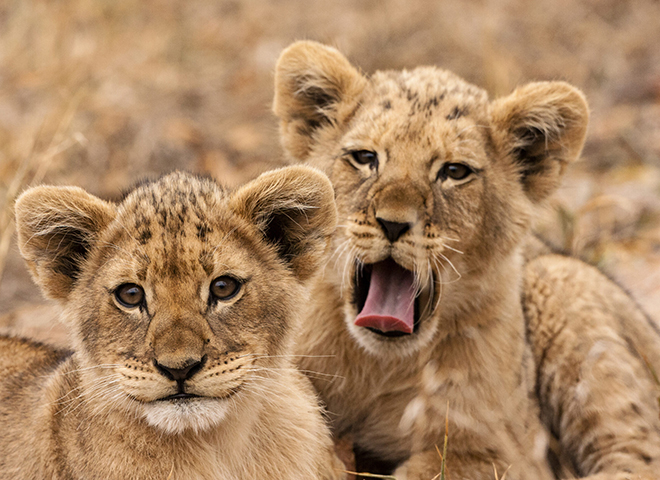
Uganda’s lions occupy three savannah-based parks. Lions structure prey behaviour and shape savannah ecology through territorial dominance and predation patterns. They live in matriarchal prides, typically consisting of 2 to 3 males and up to 15 females, along with their cubs.
You’ll find Uganda’s lions in:
- Queen Elizabeth National Park – The Ishasha sector is known globally for tree-climbing lions. These individuals rest in fig and acacia trees between 11:00 am and 2:00 pm.
- Murchison Falls National Park – Lions are concentrated along the Buligi game tracks, the delta region, and the Pakuba airstrip sector.
- Kidepo Valley National Park – Fewer in number, but frequently observed in Narus Valley during dry months.
Lions in Uganda are most active at dawn and dusk. During early morning drives (6:30 to 8:30 am), they often rest near kills or move between water points. Tree climbing, while rare across most of Africa, is habitual in Ishasha. No other park in East Africa matches its reliability for this behaviour.
Did you know? As of 2021, Uganda’s wild lion population was estimated at under 400 individuals, spread across just three parks.
Safari Viewing Tips
- Ask if UWA is running collar tracking in your chosen park; some guides use radio telemetry to locate prides.
- Remain silent and avoid off-road driving, especially in the wet season.
- Lions often rest in shaded areas; scan for twitching tails, not just full bodies.
- In Ishasha, tree branches are your best bet as the lions have adopted tree climbing
Conservation Status
- IUCN Status: Vulnerable
- Key threats in Uganda:
- Human-wildlife conflict (especially cattle predation)
- Encroachment on corridor zones
- Poisoning and retaliatory killings
Ongoing monitoring by the Wildlife Conservation Society and UWA has provided better mapping of lion movements, but long-term viability still hinges on habitat protection and buffer zone integrity.
2. The African Elephant (Loxodonta africana)
Elephants appear in both savannah and forest subspecies within Uganda. Elephants require expansive, connected ranges, making their presence a barometer of park size and ecological health. They remain listed as Endangered on the IUCN Red List.
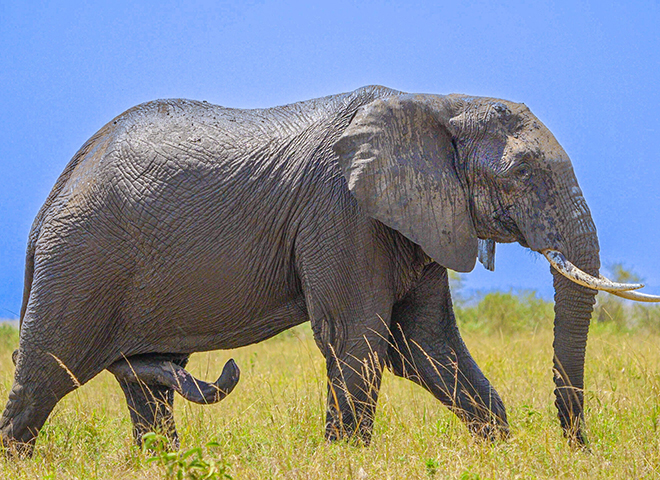
Uganda is home to both subspecies of the African elephant: the wide-ranging savannah elephant (Loxodonta africana africana) and the more elusive forest elephant (Loxodonta africana cyclotis). Very few countries in Africa host both ecologically viable numbers, and fewer still offer park access where visitors can differentiate between them.
Savannah elephants are the more commonly seen. They occupy the open plains and river corridors of Murchison Falls, Queen Elizabeth, and Kidepo Valley national parks. Murchison Falls NP alone supports more than 1,300 individuals, making it Uganda’s primary elephant range. These elephants move in extended family units, led by matriarchs, and are often seen traversing palm clearings, bathing in mud wallows, or feeding on borassus fruit near the delta.
Queen Elizabeth NP’s elephant population is less dense but more widely distributed. Sightings occur around Kasenyi, Mweya, and the Katwe-Kikorongo crater belt. Elephants in this region regularly cross roads and salt pans, especially between 9:00 am and 11:00 am. In Kidepo, dry season sightings occur near Apoka and the seasonal pools in the Narus Valley.
Forest elephants present a different challenge. Found in Kibale, Semuliki, and parts of Bwindi, these smaller, darker animals prefer closed-canopy rainforest. Unlike their savannah relatives, they rarely form herds larger than five. Their presence is best inferred from signs: broken lianas, dung piles, or deep forest tracks. Kibale offers the best (if still limited) visibility, especially near Kanyanchu and along the Sebitoli–Kamwenge road.
| Park | Subspecies | Best Zones | Timing |
| Murchison Falls NP | Savannah | Delta, Buligi, Red Chilli Circuit | Early morning, late afternoon |
| Queen Elizabeth NP | Savannah | Mweya, Kasenyi, Katwe Salt Pans | 9:00–11:00 am and 4:00–6:00 pm |
| Kibale NP | Forest | Kanyanchu, Sebitoli sector | Rare; best during fruiting season |
| Semuliki NP | Forest | Toro-Semuliki Trail, Kirumia | Difficult to predict |
| Kidepo Valley NP | Savannah | Narus Valley water points | Dry season best |
Conservation Notes
- IUCN Red List Status (2021): Endangered
- National population estimate: Between 2,400 and 3,000 individuals
- Main threats:
- Historical poaching (1970s–1990s)
- Habitat encroachment in corridors, particularly around Queen Elizabeth NP
- Human-elephant conflict in buffer communities
UWA currently monitors known elephant corridors, particularly between Queen Elizabeth and Virunga ecosystems, and is working with NGOs to install early-warning beehive fences—an effective deterrent against crop raids.
Elephants remain emotionally complex, long-lived, and socially bonded. Their presence in a park often signals ecological stability. If you see them up close, even just once, take a few seconds to observe the calves. There’s always one trailing behind, ears flapping half-heartedly, trunk still learning where to go.
3. The African Leopard (Panthera pardus)
The leopard holds the broadest range of the five but is also the most elusive. A solitary ambush predator, it prefers thick cover and often shifts activity to nighttime hours.
In Uganda, leopards appear across several parks, though their low detection rates demand patience. Population data is limited, but the species is under increasing threat from bushmeat snares and habitat fragmentation.
Solitary, mostly nocturnal, and highly territorial, the African leopard is the least observed of Uganda’s Big Five. Yet it occurs in more protected areas than any of the others—just rarely on cue. Leopards operate on stealth and silence. They often live metres from human paths without ever being seen.
Distribution in Uganda
Leopards are present in Queen Elizabeth, Murchison Falls, Kidepo Valley, Lake Mburo, and Semuliki national parks.
- Queen Elizabeth NP offers the most consistent sightings, especially around the Mweya Peninsula, Kasenyi extension, and near the Kazinga Channel drive.
- In Murchison Falls NP, focus on the Chobe sector, Queen’s track, and areas west of the Albert Nile during evening drives.
- Lake Mburo NP provides surprising visibility given its size; habituation near Ruroko Track and Kazuma Lookout has allowed more daylight movement.
- Kidepo Valley NP has confirmed presence in rocky outcrops near Apoka and along seasonal riverbeds, but actual sightings remain infrequent.
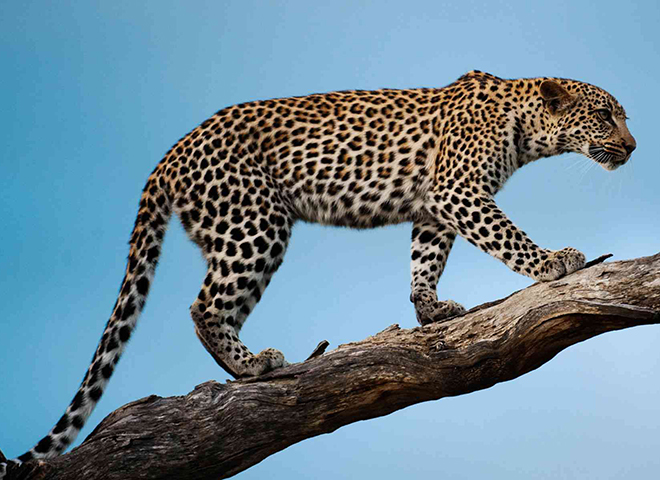
Forest edge zones, such as Semuliki’s Kirumia Trail, also support leopard populations. However, sightings in such environments are nearly impossible without camera traps or scent stations.
Behaviour & Field Recognition
- Leopards weigh between 40 and 90 kg, with males larger than females.
- Their coat features black rosettes on golden fur; juveniles may appear darker.
- Movement is most active between 6:30 pm and 3:00 am, although early mornings during the dry season also yield sightings.
Look for them in:
- Shallow gullies, where they ambush bushbuck or kob.
- Tree forks, especially near known kills.
- Termite mounds, where they rest or scout in grassland zones.
A kill hoisted into a tree (often an impala or small kob) is the strongest indicator of nearby presence. Vultures circling above a dense canopy without landing may also signal a hidden leopard.
Viewing Tips
- Night drives authorised by UWA (e.g. in Mweya or Chobe) offer the best conditions.
- Use a red or amber spotlight to reduce glare and stress to the animal.
- Avoid engine revving or loud chatter once a sighting is confirmed.
- Bushbuck, waterbuck, and baboon alarm calls often precede leopard movement — listen closely.
Conservation Status
- IUCN Status: Vulnerable
- Uganda lacks precise national population data due to low visibility and poor coverage.
- Major threats include:
- Snares laid for bushmeat (leopards are often collateral damage)
- Livestock retaliation outside park zones
- Forest encroachment in western Uganda
Conservation agencies like the Wildlife Conservation Society have deployed camera traps in Kasenyi and Mweya sectors, generating key data on density and movement patterns. Even so, the leopard remains one of the most understudied carnivores in the country.
If you see one, and not everyone does, watch it until it disappears. You likely won’t get a second chance that day.
4. The African Buffalo (Syncerus caffer)
lives in Uganda’s lowland woodlands, where it aggregates in herds exceeding 200 individuals. Unlike its domestic cousins, the wild African buffalo displays unpredictable behaviour and is considered dangerous when wounded or isolated. This species does not require intact forest and adapts well to savannah mosaics with permanent water access. It is not currently threatened, but it is a major host for zoonotic diseases.
Bulls can weigh over 800 kilograms, and dominant individuals lead herds that can exceed 300 during dry months. Although their temperament appears passive from a distance, buffalo respond aggressively if need be.
National Presence and Key Parks
Buffalo inhabit most of Uganda’s lowland savannah parks. You can expect reliable sightings in:
- Queen Elizabeth National Park — Herds concentrate along the Kazinga Channel, Kasenyi plains, and the Katwe crater zone.
- Murchison Falls National Park — Common across the Buligi circuit, the delta area, and near Red Chilli camp.
- Kidepo Valley National Park — Especially visible in the Narus Valley, where waterholes draw herds during the dry season.
- Lake Mburo National Park — Smaller herds, often near the Warukiri wetland and along the Kazuma track.
Sightings are most frequent in the early morning and late afternoon. During midday, buffalo retreat to shade and wallows. In dry months, mud pools and salt licks attract multiple species. Buffalo often share these spots with elephants and warthogs.

Behaviour and Social Structure
- Herds contain adult females, sub-adults, and calves, led by a senior cow.
- Males form bachelor groups or remain solitary, particularly older bulls.
- Calves are vulnerable to lion predation, especially when isolated near water edges.
Buffalo are often accompanied by oxpeckers, which feed on external parasites. This mutualism provides visible clues to observers. If a group of oxpeckers takes flight suddenly, a predator may be nearby.
Guides will often point out lone bulls resting in wallows. These are not outcasts, just males preserving energy away from the herd.
Conservation and Disease Monitoring
- IUCN Status: Least Concern
- Uganda’s buffalo population is considered stable and well-managed within park boundaries.
- Recent estimates (2020) suggest over 25,000 individuals across major savannah parks.
Despite their resilience, buffalo remain vulnerable to livestock-related diseases such as bovine tuberculosis, brucellosis, and foot-and-mouth disease. The Uganda Wildlife Authority routinely conducts health monitoring in Queen Elizabeth and Murchison Falls to prevent transmission to community herds outside park borders.
In dry months, buffalo are among the most photogenic species. You’ll often find them standing still in water, chewing slowly, flicking their tails with exaggerated rhythm. If the guide asks you to stay quiet, do so without question. A buffalo’s patience is deep, but not endless.
5. The Southern White Rhinoceros (Ceratotherium simum)
Uganda’s rhinoceroses exist under fully protected conditions within Ziwa Rhino Sanctuary, located along the Kampala–Gulu highway in Nakasongola District. This sanctuary, covering over 70 square kilometres, was established to reverse the national extinction of rhinos following decades of poaching, war, and habitat collapse.
Rhinos once roamed Uganda’s savannahs freely, but by 1983, both black and white rhino species had vanished from the wild. In 2005, the Rhino Fund Uganda and Uganda Wildlife Authority began reintroducing southern white rhinos (Ceratotherium simum simum) sourced from Solio Ranch in Kenya and the Disney Animal Kingdom in the United States.
Today, Ziwa is home to over 35 rhinos, including several second-generation calves born within the sanctuary’s boundaries.
What to Expect at Ziwa Rhino Sanctuary
Ziwa is not a zoo. Visitors participate in guided on-foot tracking experiences, often walking 1 to 3 kilometres to reach rhino groups. These excursions are led by trained rangers from Rhino Fund Uganda and armed UWA escorts.
- Best time for tracking:
- Morning: 7:30 to 10:00 am
- Late afternoon: 4:00 to 6:00 pm
- Distance regulation: Visitors must stay at least 7 metres away from any rhino at all times.
- Other wildlife at Ziwa includes oribi, reedbuck, bushbuck, and over 300 bird species, including the shoebill stork in the wet season.
The sanctuary operates with a full-time monitoring system. All rhinos are tagged and tracked daily. Rangers collect data on health, movement, mating, and birth. Veterinary response is available on-site, and incidents of human intrusion are near zero.
It may seem scripted at first, but the experience is fully wild. You’ll be walking among rhinos that were born in the bush, raised without human contact beyond management, and guarded every single night.
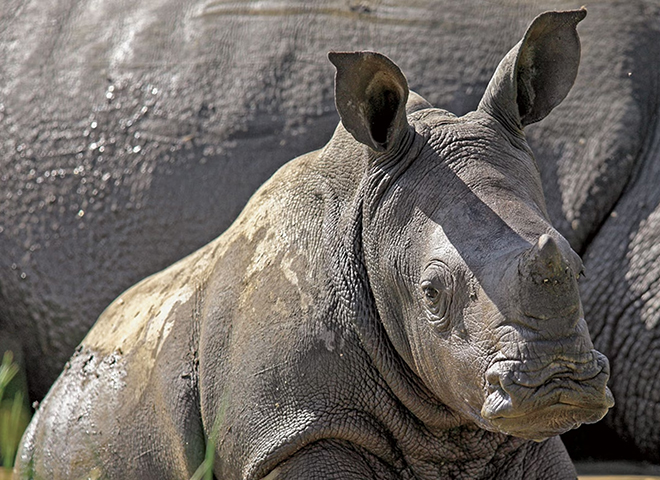
Conservation Strategy and Long-Term Goals
- IUCN Status: Near Threatened
- Ziwa’s breeding success has led to discussions on re-wilding rhinos into Murchison Falls National Park.
- Reintroduction depends on security, anti-poaching capacity, and habitat corridor integrity.
- Rhino Fund Uganda operates independently but under UWA supervision. Funding comes from tourism, donor grants, and conservation partnerships.
The goal is not just species restoration, but full ecological reintegration. Rhinos play a significant role in shaping grassland structure, dispersing seeds, and creating wallows used by other wildlife.
Visitors to Ziwa directly support this effort. Entry fees and tracking permits fund ranger salaries, fencing maintenance, and community sensitisation in neighbouring districts.
If Uganda succeeds in returning rhinos to the wild within the next decade, it will be one of the few countries in Africa to bring all Big Five species back from national extinction.
Where to see the Big 5 in Uganda
a. Queen Elizabeth National Park
Location: Southwestern Uganda
Access: 6–7 hours by road from Kampala or 1 hour by air (Mweya Airstrip)
Habitat: Lowland savannah, crater lakes, wetlands, and forest margins
Queen Elizabeth NP is the most accessible Big Five park in Uganda and the only one where lions, elephants, leopards, and buffalo are all seen in the same drive circuit. Rhinos are not present here.
- Lions are most visible in the Kasenyi Plains and Ishasha sector (tree-climbing).
- Leopards frequent the Mweya Peninsula, often near staff quarters and Katunguru Bridge.
- Elephants are common around crater lakes and the Katwe-Kasenyi corridor.
- Buffalo aggregate around the Kazinga Channel, especially near Lake Edward in the dry season.
Queen Elizabeth NP hosts over 600 bird species and is a strong choice for mixed-interest safaris.
Permits for night drives (needed for leopards) are arranged through UWA or lodge-based vehicle operators. Boat cruises along the Kazinga Channel offer bonus views of buffalo and elephants at the water’s edge.
b. Murchison Falls National Park
Location: Northwestern Uganda
Access: 4–5 hours from Kampala to Masindi; 2 hours more to the park gate
Habitat: Riverine woodland, open savannah, Borassus palm savannah
Murchison Falls NP offers four of the Big Five (no rhinos). It also ranks highest for elephant sightings and is second only to Queen Elizabeth for lions and buffalo.
- Elephants dominate the delta area, Buligi circuit, and riverbank forest edge.
- Lions are found near Pakuba, Paraa, and the delta tracks. Best seen early morning.
- Leopards use the Chobe and Red Chilli sectors. Sightings possible from 6:30 pm onward.
- Buffalo roam widely, often resting near game drive intersections.
Nocturnal drives must be booked with UWA guides. Boat trips to the base of Murchison Falls offer views of elephants crossing the river and buffalo lounging in shallow reeds.
Notably, Murchison is a strong future candidate for rhino reintroduction. Corridor studies have already begun.
READ ALSO: Murchison Falls: History, Wildlife, and Significance
c. Kidepo Valley National Park
Location: Northeastern Uganda, bordering South Sudan
Access: 10–12 hours by road from Kampala or 1.5 hours by chartered flight
Habitat: Dry savannah, seasonal rivers, rocky hills, acacia plains
Kidepo is Uganda’s wildest Big Five destination. Due to its isolation, it receives fewer visitors, which benefits species visibility — particularly for lion and buffalo. Elephants and leopards are also present.
- Lions concentrate in the Narus Valley, sometimes resting on termite mounds in plain view.
- Buffalo are abundant in the dry season, gathering near Narus pools and behind Apoka.
- Elephants appear sporadically near watering points or mineral licks.
- Leopards are confirmed in the park, though actual sightings remain rare.
Kidepo is not suitable for rhino viewing. It is, however, home to cheetah (in the adjacent Karenga region) and over 450 bird species, including the Karamoja apalis and ostrich.
Kidepo offers one of East Africa’s highest probabilities for observing large buffalo herds in open savannah without crowding.
d. Lake Mburo National Park
Location: Western Uganda, near Mbarara
Access: 3.5–4 hours from Kampala
Habitat: Woodland savannah, lakes, and rolling hills
Lake Mburo NP is the smallest Big Five site and supports only buffalo and leopard. Lions and elephants are absent. Rhinos do not occur here.
- Buffalo are common near Warukiri, Kazuma Lookout, and Miriti Swamp.
- Leopard sightings occur during night drives, often near the lakeshore or boundary tracks.
Mburo is the only park where walking safaris and horseback rides are permitted. These activities bring guests into closer contact with buffalo and other plains game like zebra, impala, and eland.
Night drives require UWA clearance and are most successful during the dry season.
e. Ziwa Rhino Sanctuary
Location: Nakasongola District, en route to Murchison Falls
Access: 3–4 hours from Kampala
Habitat: Managed savannah, woodland, and seasonal wetland
Ziwa is Uganda’s only rhino viewing destination. It is not a national park but functions as a fully fenced conservation facility where over 35 southern white rhinos are monitored.
Visitors participate in guided on-foot tracking, with ranger teams leading small groups to observe rhinos in their natural foraging zones. Shoebill tracking and birding tours are also available within the sanctuary’s wetland systems.
Ziwa completes Uganda’s Big Five circuit. Without it, the country would lack rhino tourism entirely.
Plans to relocate a founding group into open parkland are under review, but Ziwa remains the only operational rhino tourism site for now.
Conclusion
Each species classified under the Big Five presents a distinct ecological reality in Uganda. Sightings depend on space, time, behaviour, and the structure of the parks themselves. No single circuit guarantees all five in a single journey. What matters is the integrity of the habitat, the consistency of protection, and the readiness to observe according to field conditions.
Uganda’s national parks and conservation sanctuaries provide a functional Big Five portfolio. Their presence is not symbolic. It reflects tracked herds, recorded births, protected corridors, and long-term species management across multiple ecosystems. The visibility of these animals is not staged for tourism. It is a result of institutional frameworks, ranger operations, and ecological stability maintained across decades.
If you are working toward a visit, keep your research specific. The difference between partial and complete observation often depends on a single sector or the hour of the drive. This is not a checklist safari destination. It is a system of protected ranges that continues to hold.







